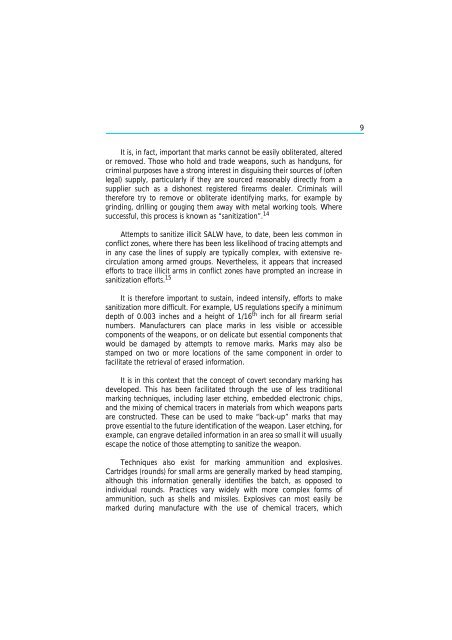The Scope and Implications of a Tracing Mechanism for Small Arms ...
The Scope and Implications of a Tracing Mechanism for Small Arms ...
The Scope and Implications of a Tracing Mechanism for Small Arms ...
Create successful ePaper yourself
Turn your PDF publications into a flip-book with our unique Google optimized e-Paper software.
9<br />
It is, in fact, important that marks cannot be easily obliterated, altered<br />
or removed. Those who hold <strong>and</strong> trade weapons, such as h<strong>and</strong>guns, <strong>for</strong><br />
criminal purposes have a strong interest in disguising their sources <strong>of</strong> (<strong>of</strong>ten<br />
legal) supply, particularly if they are sourced reasonably directly from a<br />
supplier such as a dishonest registered firearms dealer. Criminals will<br />
there<strong>for</strong>e try to remove or obliterate identifying marks, <strong>for</strong> example by<br />
grinding, drilling or gouging them away with metal working tools. Where<br />
successful, this process is known as “sanitization”. 14<br />
Attempts to sanitize illicit SALW have, to date, been less common in<br />
conflict zones, where there has been less likelihood <strong>of</strong> tracing attempts <strong>and</strong><br />
in any case the lines <strong>of</strong> supply are typically complex, with extensive recirculation<br />
among armed groups. Nevertheless, it appears that increased<br />
ef<strong>for</strong>ts to trace illicit arms in conflict zones have prompted an increase in<br />
sanitization ef<strong>for</strong>ts. 15<br />
It is there<strong>for</strong>e important to sustain, indeed intensify, ef<strong>for</strong>ts to make<br />
sanitization more difficult. For example, US regulations specify a minimum<br />
depth <strong>of</strong> 0.003 inches <strong>and</strong> a height <strong>of</strong> 1/16 th inch <strong>for</strong> all firearm serial<br />
numbers. Manufacturers can place marks in less visible or accessible<br />
components <strong>of</strong> the weapons, or on delicate but essential components that<br />
would be damaged by attempts to remove marks. Marks may also be<br />
stamped on two or more locations <strong>of</strong> the same component in order to<br />
facilitate the retrieval <strong>of</strong> erased in<strong>for</strong>mation.<br />
It is in this context that the concept <strong>of</strong> covert secondary marking has<br />
developed. This has been facilitated through the use <strong>of</strong> less traditional<br />
marking techniques, including laser etching, embedded electronic chips,<br />
<strong>and</strong> the mixing <strong>of</strong> chemical tracers in materials from which weapons parts<br />
are constructed. <strong>The</strong>se can be used to make “back-up” marks that may<br />
prove essential to the future identification <strong>of</strong> the weapon. Laser etching, <strong>for</strong><br />
example, can engrave detailed in<strong>for</strong>mation in an area so small it will usually<br />
escape the notice <strong>of</strong> those attempting to sanitize the weapon.<br />
Techniques also exist <strong>for</strong> marking ammunition <strong>and</strong> explosives.<br />
Cartridges (rounds) <strong>for</strong> small arms are generally marked by head stamping,<br />
although this in<strong>for</strong>mation generally identifies the batch, as opposed to<br />
individual rounds. Practices vary widely with more complex <strong>for</strong>ms <strong>of</strong><br />
ammunition, such as shells <strong>and</strong> missiles. Explosives can most easily be<br />
marked during manufacture with the use <strong>of</strong> chemical tracers, which
















